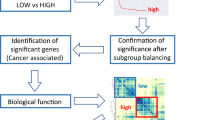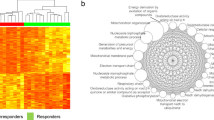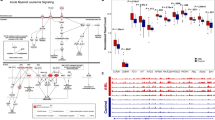Abstract
OGG1 (8-oxoguanine DNA glycosylase) constitutes a key component of the DNA base excision repair pathway, catalysing the removal of 8-oxoguanine nucleotides from DNA, thereby suppressing mutagenesis and cell death. We found that OGG1 expression was significantly downregulated by the RUNX1-ETO fusion protein product of the t(8;21) chromosome translocation in normal haematopoietic progenitor cells and in patients with acute myeloid leukaemia (AML). Further examination of OGG1 expression in 174 AML trial patients using Affymetrix microarrays showed that the prevalence rate of OGG1 expression was 33% and correlated strongly with adverse cytogenetics. OGG1-expressing patients had a worse relapse-free survival and overall survival and an increased risk of relapse at 5-years of follow-up. There remained a trend towards increased relapse rate among OGG1-expressing patients, even after adjusting for other known risk factors in comprehensive stratified analyses. We also determined a trend for OGG1 expression to have a more adverse impact on disease outcome in the context of the FLT3-ITD mutation. This study highlights OGG1 as a valuable prognostic marker that could be used to sub-stratify AML patients to predict those likely to fail conventional chemotherapies but those likely to benefit from novel therapeutic approaches that modulate DNA repair activity.
This is a preview of subscription content, access via your institution
Access options
Subscribe to this journal
Receive 50 print issues and online access
$259.00 per year
only $5.18 per issue
Buy this article
- Purchase on Springer Link
- Instant access to full article PDF
Prices may be subject to local taxes which are calculated during checkout



Similar content being viewed by others
References
Alcalay M, Meani N, Gelmetti V, Fantozzi A, Fagioli M, Orleth A et al. (2003). Acute myeloid leukemia fusion proteins deregulate genes involved in stem cell maintenance and DNA repair. J Clin Invest 112: 1751–1761.
Beillard E, Pallisgaard N, van der Velden VH, Bi W, Dee R, van der SE et al. (2003). Evaluation of candidate control genes for diagnosis and residual disease detection in leukemic patients using ‘real-time’ quantitative reverse-transcriptase polymerase chain reaction (RQ-PCR)—a Europe against cancer program. Leukemia 17: 2474–2486.
Bennett JM, Catovsky D, Daniel MT, Flandrin G, Galton DA, Gralnick HR et al. (1985). Proposed revised criteria for the classification of acute myeloid leukemia. A report of the French-American-British Cooperative Group. Ann Intern Med 103: 620–625.
Bullinger L, Rucker FG, Kurz S, Du J, Scholl C, Sander S et al. (2007). Gene-expression profiling identifies distinct subclasses of core binding factor acute myeloid leukemia. Blood 110: 1291–1300.
Chatterjee A, Mambo E, Zhang Y, Deweese T, Sidransky D . (2006). Targeting of mutant hogg1 in mammalian mitochondria and nucleus: effect on cellular survival upon oxidative stress. BMC Cancer 6: 235.
de Souza-Pinto NC, Eide L, Hogue BA, Thybo T, Stevnsner T, Seeberg E et al. (2001). Repair of 8-oxodeoxyguanosine lesions in mitochondrial dna depends on the oxoguanine dna glycosylase (OGG1) gene and 8-oxoguanine accumulates in the mitochondrial dna of OGG1-defective mice. Cancer Res 61: 5378–5381.
Erickson P, Gao J, Chang KS, Look T, Whisenant E, Raimondi S et al. (1992). Identification of breakpoints in t(8;21) acute myelogenous leukemia and isolation of a fusion transcript, AML1/ETO, with similarity to Drosophila segmentation gene, runt. Blood 80: 1825–1831.
Fishel ML, Seo YR, Smith ML, Kelley MR . (2003). Imbalancing the DNA base excision repair pathway in the mitochondria; targeting and overexpressing N-methylpurine DNA glycosylase in mitochondria leads to enhanced cell killing. Cancer Res 63: 608–615.
Floyd RA . (1990). The role of 8-hydroxyguanine in carcinogenesis. Carcinogenesis 11: 1447–1450.
Frosina G . (2000). Overexpression of enzymes that repair endogenous damage to DNA. Eur J Biochem 267: 2135–2149.
Grignani F, Kinsella T, Mencarelli A, Valtieri M, Riganelli D, Grignani F et al. (1998). High-efficiency gene transfer and selection of human hematopoietic progenitor cells with a hybrid EBV/retroviral vector expressing the green fluorescence protein. Cancer Res 58: 14–19.
Grimwade D, Walker H, Oliver F, Wheatley K, Harrison C, Harrison G et al. (1998). The importance of diagnostic cytogenetics on outcome in AML: analysis of 1,612 patients entered into the MRC AML 10 trial. The Medical Research Council Adult and Children's Leukaemia Working Parties. Blood 92: 2322–2333.
Gustafson SA, Lin P, Chen SS, Chen L, Abruzzo LV, Luthra R et al. (2009). Therapy-related acute myeloid leukemia with t(8;21) (q22;q22) shares many features with de novo acute myeloid leukemia with t(8;21)(q22;q22) but does not have a favorable outcome. Am J Clin Pathol 131: 647–655.
Higuchi M, O'Brien D, Kumaravelu P, Lenny N, Yeoh EJ, Downing JR . (2002). Expression of a conditional AML1-ETO oncogene bypasses embryonic lethality and establishes a murine model of human t(8;21) acute myeloid leukemia. Cancer Cell 1: 63–74.
Hill JW, Evans MK . (2007). A novel R229Q OGG1 polymorphism results in a thermolabile enzyme that sensitizes KG-1 leukemia cells to DNA damaging agents. Cancer Detect Prev 31: 237–243.
Husain A, He G, Venkatraman ES, Spriggs DR . (1998). BRCA1 up-regulation is associated with repair-mediated resistance to cis-diamminedichloroplatinum(II). Cancer Res 58: 1120–1123.
Hyun JW, Choi JY, Zeng HH, Lee YS, Kim HS, Yoon SH et al. (2000). Leukemic cell line, KG-1 has a functional loss of hOGG1 enzyme due to a point mutation and 8-hydroxydeoxyguanosine can kill KG-1. Oncogene 19: 4476–4479.
Hyun JW, Yoon SH, Yu Y, Han CS, Park JS, Kim HS et al. (2006). Oh8dG induces G1 arrest in a human acute leukemia cell line by upregulating P21 and blocking the RAS to ERK signaling pathway. Int J Cancer 118: 302–309.
Ishchenko A, Sinitsyna O, Krysanova Z, Vasyunina EA, Saparbaev M, Sidorkina O et al. (2003). Age-dependent increase of 8-oxoguanine-, hypoxanthine-, and uracil- DNA glycosylase activities in liver extracts from OXYS rats with inherited overgeneration of free radicals and Wistar rats. Med Sci Monit 9: BR16–BR24.
Jankowska AM, Gondek LP, Szpurka H, Nearman ZP, Tiu RV, Maciejewski JP . (2008). Base excision repair dysfunction in a subgroup of patients with myelodysplastic syndrome. Leukemia 22: 551–558.
Keating MJ, Smith TL, Kantarjian H, Cork A, Walters R, Trujillo JM et al. (1988). Cytogenetic pattern in acute myelogenous leukemia: a major reproducible determinant of outcome. Leukemia 2: 403–412.
Kinsella TJ . (2009). Coordination of DNA mismatch repair and base excision repair processing of chemotherapy and radiation damage for targeting resistant cancers. Clin Cancer Res 15: 1853–1859.
Kitabayashi I, Yokoyama A, Shimizu K, Ohki M . (1998). Interaction and functional cooperation of the leukemia-associated factors AML1 and p300 in myeloid cell differentiation. EMBO J 17: 2994–3004.
Klungland A, Rosewell I, Hollenbach S, Larsen E, Daly G, Epe B et al. (1999). Accumulation of premutagenic DNA lesions in mice defective in removal of oxidative base damage. Proc Natl Acad Sci USA 96: 13300–13305.
Krejci O, Wunderlich M, Geiger H, Chou FS, Schleimer D, Jansen M et al. (2008). p53 signaling in response to increased DNA damage sensitizes AML1-ETO cells to stress-induced death. Blood 111: 2190–2199.
Liu P, Tarle SA, Hajra A, Claxton DF, Marlton P, Freedman M et al. (1993). Fusion between transcription factor CBF beta/PEBP2 beta and a myosin heavy chain in acute myeloid leukemia. Science 261: 1041–1044.
Livak KJ, Schmittgen TD . (2001). Analysis of relative gene expression data using real-time quantitative PCR and the 2(-Delta Delta C(T)) method. Methods 25: 402–408.
Miyoshi H, Shimizu K, Kozu T, Maseki N, Kaneko Y, Ohki M . (1991). t(8;21) breakpoints on chromosome 21 in acute myeloid leukemia are clustered within a limited region of a single gene, AML1. Proc Natl Acad Sci USA 88: 10431–10434.
Nishioka K, Ohtsubo T, Oda H, Fujiwara T, Kang D, Sugimachi K et al. (1999). Expression and differential intracellular localization of two major forms of human 8-oxoguanine DNA glycosylase encoded by alternatively spliced OGG1 mRNAs. Mol Biol Cell 10: 1637–1652.
Oshimura M, Ohyashiki K, Mori M, Terada H, Takaku F . (1982). Cytogenetic and hematologic findings in acute myelogenous leukemia, M2 according to the FAB classification. Gann 73: 212–216.
Osterod M, Hollenbach S, Hengstler JG, Barnes DE, Lindahl T, Epe B . (2001). Age-related and tissue-specific accumulation of oxidative DNA base damage in 7,8-dihydro-8-oxoguanine-DNA glycosylase (Ogg1) deficient mice. Carcinogenesis 22: 1459–1463.
Peterson LF, Yan M, Zhang DE . (2007). The p21Waf1 pathway is involved in blocking leukemogenesis by the t(8;21) fusion protein AML1-ETO. Blood 109: 4392–4398.
Peterson LF, Zhang DE . (2004). The 8;21 translocation in leukemogenesis. Oncogene 23: 4255–4262.
Quesnel B, Kantarjian H, Bjergaard JP, Brault P, Estey E, Lai JL et al. (1993). Therapy-related acute myeloid leukemia with t(8;21), inv(16), and t(8;16): a report on 25 cases and review of the literature. J Clin Oncol 11: 2370–2379.
Radyuk SN, Michalak K, Rebrin I, Sohal RS, Orr WC . (2006). Effects of ectopic expression of Drosophila DNA glycosylases dOgg1 and RpS3 in mitochondria. Free Radic Biol Med 41: 757–764.
Rombouts WJ, Blokland I, Lowenberg B, Ploemacher RE . (2000). Biological characteristics and prognosis of adult acute myeloid leukemia with internal tandem duplications in the Flt3 gene. Leukemia 14: 675–683.
Ross ME, Mahfouz R, Onciu M, Liu HC, Zhou X, Song G et al. (2004). Gene expression profiling of pediatric acute myelogenous leukemia. Blood 104: 3679–3687.
Saebo M, Skjelbred CF, Nexo BA, Wallin H, Hansteen IL, Vogel U et al. (2006). Increased mRNA expression levels of ERCC1, OGG1 and RAI in colorectal adenomas and carcinomas. BMC Cancer 6: 208.
Sallmyr A, Fan J, Datta K, Kim KT, Grosu D, Shapiro P et al. (2008). Internal tandem duplication of FLT3 (FLT3/ITD) induces increased ROS production, DNA damage, and misrepair: implications for poor prognosis in AML. Blood 111: 3173–3182.
Shirota Y, Stoehlmacher J, Brabender J, Xiong YP, Uetake H, Danenberg KD et al. (2001). ERCC1 and thymidylate synthase mRNA levels predict survival for colorectal cancer patients receiving combination oxaliplatin and fluorouracil chemotherapy. J Clin Oncol 19: 4298–4304.
Sunaga N, Kohno T, Shinmura K, Saitoh T, Matsuda T, Saito R et al. (2001). OGG1 protein suppresses G:C—>T:A mutation in a shuttle vector containing 8-hydroxyguanine in human cells. Carcinogenesis 22: 1355–1362.
Tonks A, Pearn L, Musson M, Gilkes A, Mills KI, Burnett AK et al. (2007). Transcriptional dysregulation mediated by RUNX1-RUNX1T1 in normal human progenitor cells and in acute myeloid leukaemia. Leukemia 21: 2495–2505.
Tonks A, Tonks AJ, Pearn L, Pearce L, Hoy T, Couzens S et al. (2004). Expression of AML1-ETO in human myelomonocytic cells selectively inhibits granulocytic differentiation and promotes their self-renewal. Leukemia 18: 1238–1245.
Van Der Kemp PA, Thomas D, Barbey R, de OR, Boiteux S . (1996). Cloning and expression in Escherichia coli of the OGG1 gene of Saccharomyces cerevisiae, which codes for a DNA glycosylase that excises 7,8-dihydro-8-oxoguanine and 2,6-diamino-4-hydroxy-5-N-methylformamidopyrimidine. Proc Natl Acad Sci USA 93: 5197–5202.
Viale A, De FF, Orleth A, Cambiaghi V, Giuliani V, Bossi D et al. (2009). Cell-cycle restriction limits DNA damage and maintains self-renewal of leukaemia stem cells. Nature 457: 51–56.
Weiss JM, Goode EL, Ladiges WC, Ulrich CM . (2005). Polymorphic variation in hOGG1 and risk of cancer: a review of the functional and epidemiologic literature. Mol Carcinog 42: 127–141.
Xie Y, Yang H, Cunanan C, Okamoto K, Shibata D, Pan J et al. (2004). Deficiencies in mouse Myh and Ogg1 result in tumor predisposition and G to T mutations in codon 12 of the K-ras oncogene in lung tumors. Cancer Res 64: 3096–3102.
Yergeau DA, Hetherington CJ, Wang Q, Zhang P, Sharpe AH, Binder M et al. (1997). Embryonic lethality and impairment of haematopoiesis in mice heterozygous for an AML1-ETO fusion gene. Nat Genet 15: 303–306.
Acknowledgements
This study was supported by the Wales Office of Research and Development (Welsh Assembly Government) and the Medical Research Council UK. Dr A Tonks is also supported by Leukaemia Research UK. We thank Amanda Gilkes and Megan Musson (Cardiff University) for their technical assistance in processing microarray samples. We also thank Professor Ken Mills (Queen's University, Belfast) for help in microarray analyses. We acknowledge the MRC for access to patient sample material enrolled in the NCRI clinical trials.
Author information
Authors and Affiliations
Corresponding author
Additional information
Supplementary Information accompanies the paper on the Oncogene website (http://www.nature.com/onc)
Rights and permissions
About this article
Cite this article
Liddiard, K., Hills, R., Burnett, A. et al. OGG1 is a novel prognostic indicator in acute myeloid leukaemia. Oncogene 29, 2005–2012 (2010). https://doi.org/10.1038/onc.2009.462
Received:
Revised:
Accepted:
Published:
Issue Date:
DOI: https://doi.org/10.1038/onc.2009.462
Keywords
This article is cited by
-
Lower RNA expression of ALDH1A1 distinguishes the favorable risk group in acute myeloid leukemia
Molecular Biology Reports (2022)
-
AML1/ETO and its function as a regulator of gene transcription via epigenetic mechanisms
Oncogene (2021)
-
Genetic Investigation of Polymorphic OGG1 and MUTYH Genes Towards Increased Susceptibility in Lung Adenocarcinoma and its Impact on Overall Survival of Lung Cancer Patients Treated with Platinum Based Chemotherapy
Pathology & Oncology Research (2019)
-
Association between OGG1 S326C CC genotype and elevated relapse risk in acute myeloid leukemia
International Journal of Hematology (2018)
-
The leukemia-associated RUNX1/ETO oncoprotein confers a mutator phenotype
Leukemia (2016)



